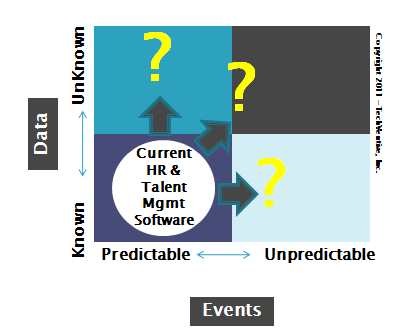Next Gen Strategic HR Software (Part I)

One of the first payroll packages ever written was created in the 1950s for GE on a Univac computer system. I use this piece of historical trivia to point out one very important aspect of payroll and HR systems: they have been done to death.
We are rapidly coming upon the annual HR Technology show this October. In my opinion, this is the single largest gathering of HR vendors and potential HR software buyers in North America. Thousands of attendees will circulate amongst the meetings, keynotes and exhibition hall while debating the relative merits of the products mentioned within. I'll be there, too. But I'll be looking for more than the basics. I'll be looking for specific examples of strategic innovation.
Financial, ERP and HR vendors have been very good at dealing with known, predictable business events and data.
These vendors have taken the routine activities impacting businesses and all other stakeholders (e.g., employees, customers, suppliers, accountants, external auditors, etc.) to a highly controlled, secured and well understood set of business processes, workflows and other outcomes.
In accounting circles, accountants have continued to polish Luca Pacioli's accounting rules over the last 500+ years to create the financial accounting records and systems we know today. In the last century or so, managerial accounting has sprung up to help operational leaders within firms better understand and gain insights into manufacturing, costing, and other views of their business. But, businesses are paying big bucks to CXOs to solve problems that are often unpredictable and may present themselves with skeletal or non-accounting-based data. Many of these decisions are strategic and may represent great innovation opportunities for HR and other software vendors to come.
An academic colleague of mine has a slightly different 2X2 model an insight into the phenomenon mentioned above. He argues that businesses are dealing with many known events and are using many structured forms of data to record and analyze these events.
Recently, he remarked that software firms and academics have been quite successful in studying and codifying these known for predictable events as well as understanding the accounting, business and other implications that the data surrounding these events possess. He further added that software firms and academics have not spent enough time studying unstructured data and how it impacts the many known events impacting business. And, he added, few have studied how businesses must deal with unplanned events with their limited structured data.
What all this points out is that HR, financial or ERP systems have been myopically and needlessly limited in their scope. IT systems can now handle massive data feeds and can parse extraordinary volumes of data via in-core or memory resident database technology. The innovation we need in application software is in these enormous, unstudied and unknown quadrants.
Bill Kutik, the organizer behind the HR Technology show recently wrote about a trend he's seeing in HR systems. If I recall Bill's piece correctly, he referenced that Gartner's Jim Holincheck sees HR systems evolving into three groups: book of record systems, talent management solutions and innovation. (Full disclosure: Jim and I worked together at Andersen Consulting's Software Intelligence unit.) I'd agree that there are three groups of HR technology out there with too many vendors in the first two camps. I commend those vendors that can successfully sell the book of record systems as the ROI on these is often quite limited. Outsourcers will likely continue to make in-roads in this niche. As to talent management solutions, the industry is consolidating the piece part players and large talent management suites are now everywhere. What is really interesting to me is that the two groups are often most easily delineated by the lack of cloud capabilities in the book of record solutions and the almost universal availability of cloud solutions within the talent management space.
The innovation space looks pretty sparse right now. I'm guessing that has to change and that this will be a focus of venture capital funded HR startups. The innovation is where the value will be. The innovation is what will bring energy, enthusiasm and excitement to this software sector. I'm betting that the much of the innovation will fall into those other quadrants in the models I inserted earlier in this piece.
When I attend the HR Technology show this October, this is the type of innovation I want to see. If you want to attend this show, I found a couple of early registration codes that should work for a few more weeks (SAFARI11, LINKEDIN11 - case sensitive). If you'd like some specific examples of the dilemmas that will confront innovative HR solutions, read Part II of this blog.
